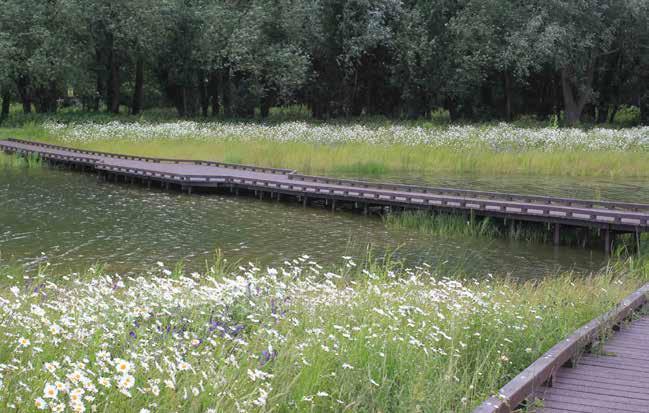
4 minute read
Ellis Meadows
Leicester, England, United Kingdom
Building a multifunctional green space for people and wildlife. The River Soar runs through the center of the city of Leicester, located in England’s East Midlands; and a major flood event would cause serious economic losses to the city. To combat this threat, the Environment Agency in partnership with Leicester City Council converted a former school playing field into a wetland and wildflower park complete with cycleway and boardwalk and reconnected the River Soar with its floodplain. Consisting of grass and decommissioned allotments, the public rarely used the site before this project; and ecologically it contributed very little. Funded in 2013 and completed in 2016, the 7.4 hectares restored at Ellis Meadows formed the second phase of a larger natural flood management project for the city. Taking a blue-green infrastructure approach to managing flood risk through a combination of land lowering and reshaping, wetland creation, and vegetation management has reduced the flood risk for over 2000 homes and businesses in Leicester. When river levels are high, it provides space for waterlowering levels upstream within the city center. The natural flood management technique worked straight away: a flash flood filled the Ellis Meadows wetland, preventing costly flood damage and demonstrating the project’s success.
Article cover: Thistles, daisies, grasses, and other native wildflowers now grow in the meadow. (Photo by Leicester City Council)
Producing Efficiencies
While most flood schemes in the United Kingdom use engineered defenses requiring environmental mitigation, Ellis Meadows’ focus on blue-green infrastructure improvements and use of local materials cost a quarter of the price of the original proposal. Even the on-going maintenance costs of the habitats created, including a wildflower meadow, are lower than the previous costs of regularly mowing the grass. The support of the city mayor has been a crucial factor in delivering the scheme in an unusually short timescale for a major flood alleviation project.
Using Natural Processes
By planting native species that can tolerate a range of water levels, retaining mature trees and scrub, and adding a species-rich native wildflower meadow and new woodland, the project team created a diverse set of habitats. Grey heron (Ardea cinera) and little egret (Egretta garzetta) sightings have already become common, as are badger foraging and commuting paths. Additionally, the site encourages soil carbon sequestration and reduces greenhouse gases. As it is on the edge of a highly urbanized area, it will help to alleviate the urban heat island effect.

Broadening Benefits
In addition to protecting Leicester and the surrounding areas in the event of a flood, the wetland also functions as a fish refuge when levels in the main River Soar are high. Ongoing monitoring shows a range of birds, bats, amphibians, and dragon- and damselflies occupy the wetland, which together with the wildflowers, cycling path, and boardwalk create a rich, biodiverse tapestry for local residents. This abandoned school field has become a popular spot for cycling, walking, barbecues, and picnics.


Promoting Collaboration
Leicester City Council, as the landowner, played an important role in helping the Environment Agency restore the site, working closely with flood, parks, education, regeneration, and highways specialists to get overall agreement on the project. Drawing on the partners’ expertise, it has been possible to engage with Leicester’s diverse population at locations and in activities that go beyond normal audiences. Influencing communities and organizations in their everyday environment has again linked local people and the waterway.









